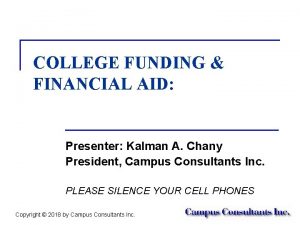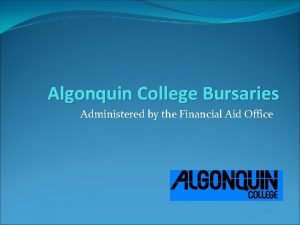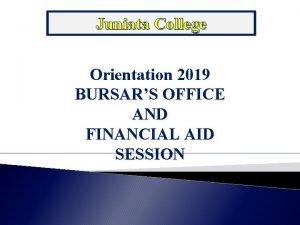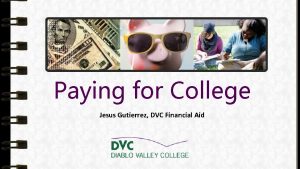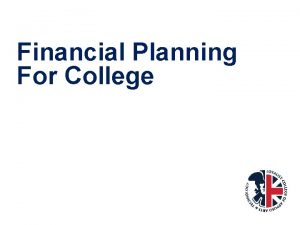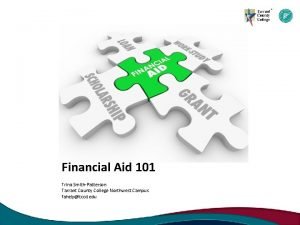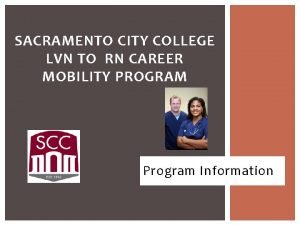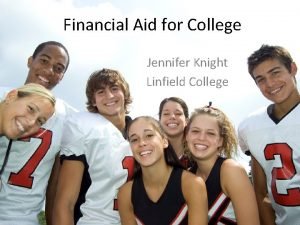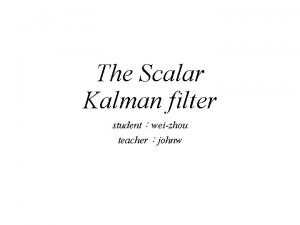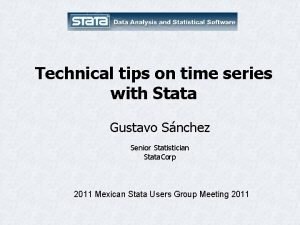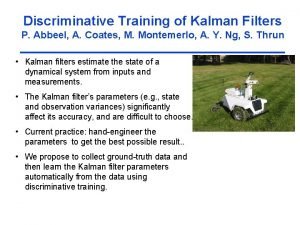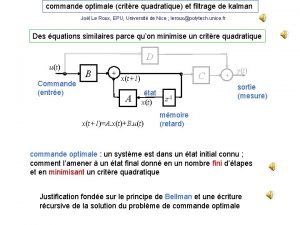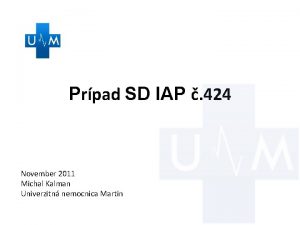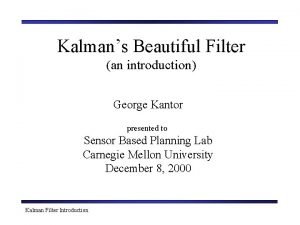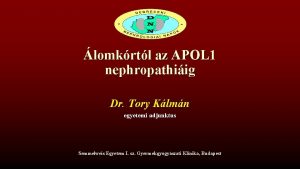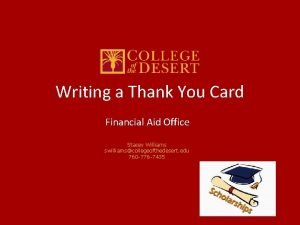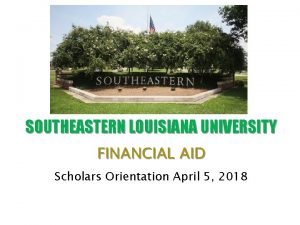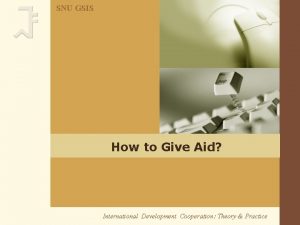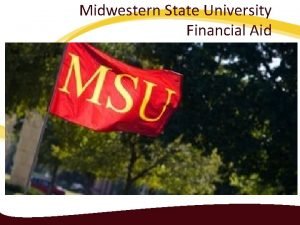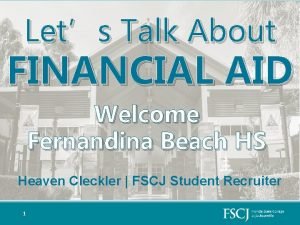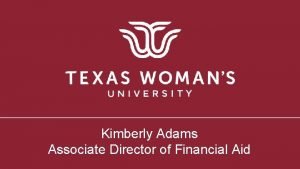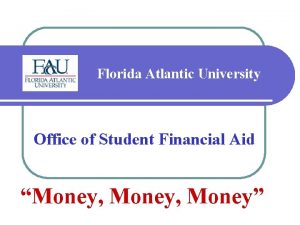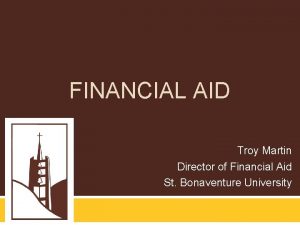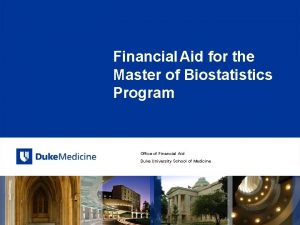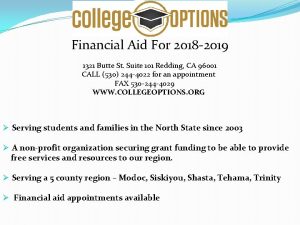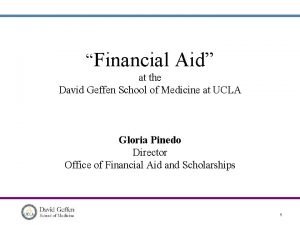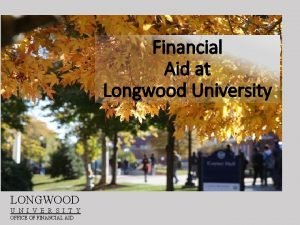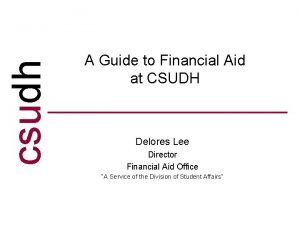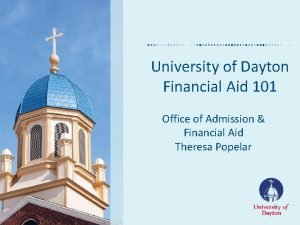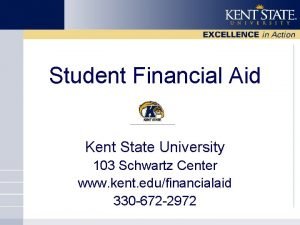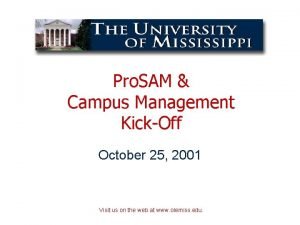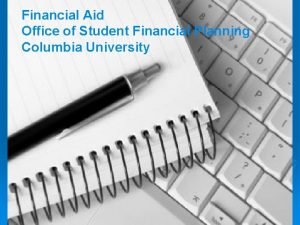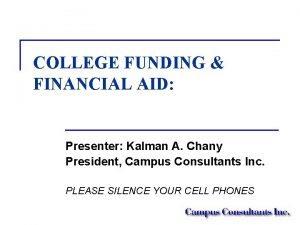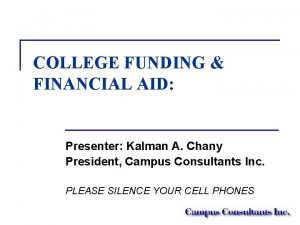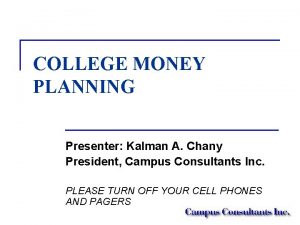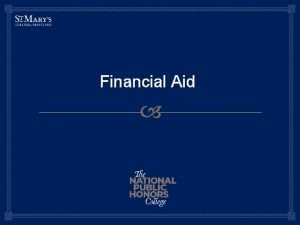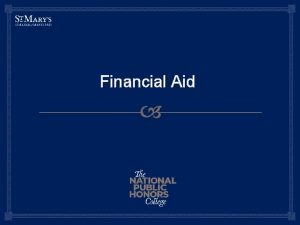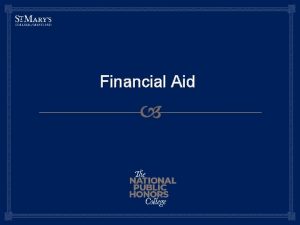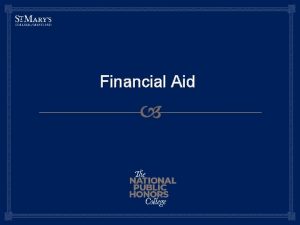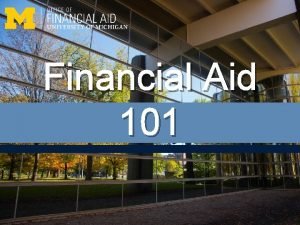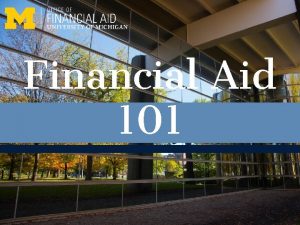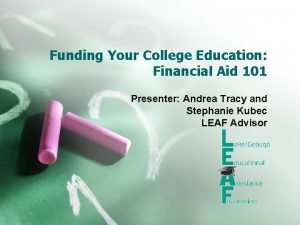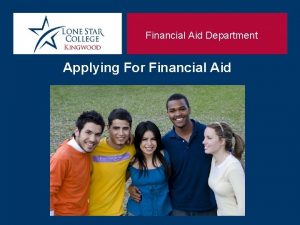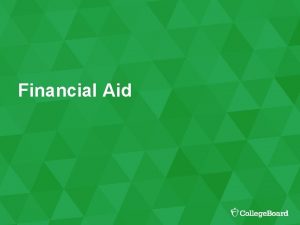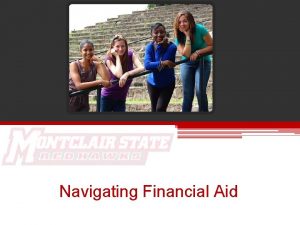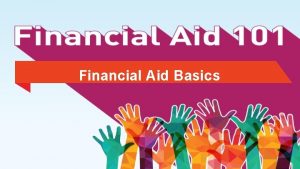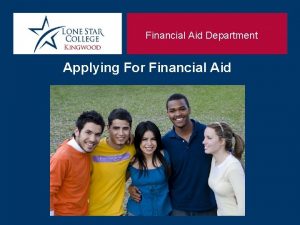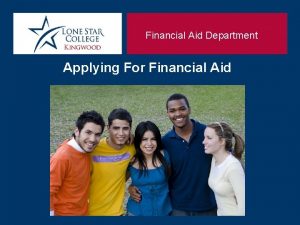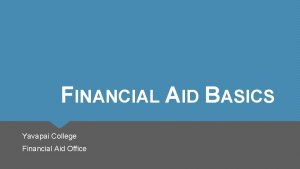COLLEGE FUNDING FINANCIAL AID Presenter Kalman A Chany











































- Slides: 43

COLLEGE FUNDING & FINANCIAL AID: Presenter: Kalman A. Chany President, Campus Consultants Inc. PLEASE SILENCE YOUR CELL PHONES Copyright © 2018 by Campus Consultants Inc.

TYPES OF FINANCIAL AID There are two types of financial aid offered: n MERIT-BASED n NEED-BASED Cost minus EFC = “Demonstrated Need” Key point: Merit-based aid reduces eligibility for need-based aid

MERIT-BASED SCHOLARSHIPS n n n Most schools award scholarships for academic ability May be necessary to file aid forms to qualify Many schools also offer scholarships to students with: Creative / performing art talent q Athletic ability q Students with a record of special achievement or who possess special characteristics NOTE: Merit aid likely not adjusted for tuition inflation q

TIPS FOR MERIT-BASED MONEY Normally awarded by admissions office – except for Athletic Scholarships (Ath. Dept). n Automatically considered when applying for admission? Or are extra steps required? n Admissions application may have to be submitted before the “normal” admissions deadline to be considered. n What are the criteria for renewal?

MYTHS REGARDING NEED-BASED AID It is NOT true that…. n There is an income cutoff for aid n You are ineligible if you own a home n Parents need to have a job to qualify for aid n The amount of aid one receives is the same at any school n The college will show one how to get the most money

ENROLLMENT MANAGEMENT n n Higher education is a major industry of the USA It is a costly mistake to assume that schools will put your child’s best interests ahead of their own Be aware that most private and many state colleges & universities engage in Financial Aid Leveraging trying to figure out the least aid to award you and still get the student to enroll! MOST IMPORTANT: FEW COLLEGES AWARD AID ON A STRCITLY FIRST COME – FIRST SERVED BASIS! (So being the first to act likely won’t help and may even hurt your chances for aid. )

FINANCIAL AID JARGON There are two key items that affect eligibility: n Cost of Attendance n Expected Family Contribution (EFC)

ITEMS IN THE COST OF ATTENDANCE The Cost of Attendance represents the sum of: n Tuition and fees n Housing and meals n Allowance for books and supplies n Allowance for transportation n Allowance for personal expenses

FACTORS AFFECTING THE EFC n Student’s status (Dependent, Independent) n Parents’ status (Dependent Students Only) n n n Living together Living apart Re-marriage

DIFFERENT STROKES FOR DIFFERENT FOLKS I will use the term “Simple situation” to describe a family situation where all of the following apply: 1) Parent income below $50, 000 (and little fluctuation) 2) Parents are married (or non-custodial parent info is not requested by any school. ) 3) If tax filer: only earned income is reported on a w-2 form issued by an employer (other than yourself) 4) Parents’ assets less than $10, 000 (and no equities) 5) Student has no assets 6) If tax filer: standard deduction regularly claimed

THE EXPECTED FAMILY CONTRIBUTION (EFC) For a dependent student: Parents’ Contribution + Student Contribution n Income and assets are currently assessed n There are two main formulas for the EFC n q q Federal Methodology (FM) Institutional Methodology (IM) BUT: Another formula for NYS TAP grant and… Different income guidelines for the NYS Excelsior Scholarship or the Enhanced Tuition Award

INCOME AND FINANCIAL AID n n n All taxable income and some types of untaxed income are subject to assessment. The base income year: the calendar year two years prior to the academic year the student is seeking assistance - so the first base year begins as early as January 1 st of 10 th grade (e. g. 2017 is “PPY” for 2019 - 2020 award yr. ) College aid officers can use “professional judgment” in certain situations. (continued)

INCOME AND FINANCIAL AID (continued) n n For the FM: Untaxed social security benefits for any family member, the earned income credit, the foreign income exclusion, and the additional child credit are not assessed. For the IM: Social security benefits paid for the benefit of the student are excluded. Benefits for others are assessed – except those of a sibling who will also be in college during the same award year as the student.

INCOME AND FINANCIAL AID (continued) n n n Income from work as well as income from other sources (defined by formula) is considered. Voluntary pre-tax contributions to retirement plans and the Health Savings Account (HSA) deduction are untaxed income items in both the FM and IM. Amounts withheld from wages for HSAs or flex spending (FSAs) for dependent care and medical spending are untaxed income items only in the IM. Taxes paid and other items are deducted from total income. Parental income after deductions may be assessed from 22% up to 47%.

STUDENT INCOME & FINANCIAL AID n n n A dependent student will be expected to contribute 50% of their after-tax income once the base-year after-tax income exceeds: $6, 660 for the 2019 -2020 FM and $4, 780 for the 2019 -2020 IM. There is no minimum expected contribution in the FM. In the 2019 -2020 IM, there is a minimum expected contribution for most dependent students: n n $2, 200 for the freshman year $2, 900 for any subsequent year

HOW IS THE HOME TREATED? n Home is defined as one’s primary residence n Not considered an asset in the FM n Considered an asset in the IM, but some schools will cap the value or the equity at a percentage of income or ignore it

ASSESSED ASSETS (FM and IM) n n Any real estate other than one’s primary residence is considered. Part of “home” rented out to a non-family member may be considered “other real estate” as well. Cash as well as the value of any bank accounts and other investments are considered, though any qualified retirement accounts (IRA, 401 k, etc. ) annuities and insurance products are excluded.

WHAT ABOUT MY DEBTS, MY BUSINESS, OR MY FARM? n n Only debts secured by assets that are assessed in the formula are recognized Unsecured debts (credit card balances, personal loans, etc. ) do not reduce one’s “net assets” The net worth of any business or farm may need to be reported. However in the FM, the net worth of any “family business” or “ family farm” is not considered as an asset Asset value = the current market value on the day the aid form is completed! So timing matters!!!!

THE CONTRIBUTION FROM ASSETS n n Certain asset protection allowances are deducted from a parent’s net assets For parent(s): Any remaining assets are assessed at a maximum rate of 5. 65% in the FM and 5% in the IM No asset protection allowance for the student Student net assets assessed at 20% in the FM and 25% in the IM

WHAT ABOUT 529 PLANS AND COVERDELLS (owned by a custodial parent of the student or the student)? n n Any parent-owned 529 plan or Coverdell account is considered a parental asset A student-owned 529 or Coverdell will be considered a parental asset for a dependent student in the FM, but a student asset in the IM.

WHAT ABOUT 529 PLANS AND COVERDELLS (owned by others)? n Any 529 or Coverdell owned by an individual other than the student or a custodial parent need not be reported as an asset, unless there is a specific question on an aid form about these accounts owned by others. However, the value of the funds withdrawn during any base income year from such an account will be considered untaxed income to the student - and can reduce aid eligibility by as much as 50 cents on the dollar.

OTHER FACTORS THAT INFLUENCE THE EFC n Number of family members in the household n For the FM: The age of the older parent (step -parent) in the household n Number of family members in the household in college on at least a half-time basis (excluding any parent/stepparent)

HOW ELIGIBILITY IS DETERMINED n Cost of Attendance – EFC = “Need” n Consider reducing any discretionary income during a base income year Certain adjustments to assets can also lower your EFC in the aid formulas Most schools engage in preferential packaging n n

FAFSA (100+ questions) FM formulas q Filing period begins October 1. Not a Deadline! q q q (Likely will not result into earlier notification of aid, just more time to wait to hear about aid. ) Prior-prior year (PPY) income to be reported All other data is as of date form is filed. PPY will allow more (but not all) filers to use IRS Data Retrieval at time of initial filing More appeals likely due to stale income data! Prior year (PY) tax returns may be required. KEY POINT: Make haste slowly. There is little margin for error with the process!!!!

CSS PROFILE (200 -300+ questions for many) IM formula n n n Detailed income questions based on PPY Less-detailed questions re: prior year income (PY) and future year income (FY) Much more detailed data asked than FAFSA. Trend: More schools will be using PROFILE to award own institutional need-based aid For schools that require the PROFILE, the PROFILE is more important than the FAFSA! Noncustodial parent PROFILE? (It depends!)

KEY STEPS TO FOLLOW 1. Determine the forms you need to 2. 3. 4. 5. 6. complete Determine your deadlines Register for the PROFILE if required Gather together your records If filing the online FAFSA, obtain FSA IDs for student as well as at least one parent / stepparent providing data on FAFSA. Submit forms by optimal date (Not ASAP!)

THE ASSERTIVE APPROACH Steps 1 -4 should be done now if not already started. It’s not too soon even if the student is in 9 th grade due to “PPY paper trail”. 1. Be an “educated” consumer 2. Calculate financial “need” and aid eligibility 3. Plan ahead to increase “need” - before you submit any aid forms!! 4. Especially if considering private colleges: get professional help early with planning 5. File forms at optimal time

TYPES OF NEED-BASED FINANCIAL AID n Grants n Work-study n Student loans

VERIFICATION (No need to panic) n Two types of Verification q q n n n Federal (Various verification categories) Institutional (may be 100% at some schools) For tax filers: Not using IRS DRT if offered on the FAFSA will increase likelihood of getting selected by processor federal verification Additional documentation required College Board’s IDOC service may be used by some schools for institutional verification

SAMPLE AWARD PACKAGE n n n n Pell Grant SEOG Grant University Grant State Grant Work-study job Subsidized Direct Loan Unsubsidized Direct Loan $2, 300 $750 $47, 000 $3, 200 $1, 750 $3, 500 $2, 000

BORROWING SOURCES n Federally-sponsored loans n Alternative loans

FEDERAL LOANS: FACTORS TO CONSIDER n Direct student loan: Subsidized versus Unsubsidized versions n Federal Direct student loans, PLUS and Grad. PLUS loans are offered only through the William D. Ford Direct Loan Program. (Private lenders no longer offer federal education loans, though may service them. )

ALTERNATIVE LOANS: FACTORS TO CONSIDER n n n n Interest rate: Fixed or variable? How determined? Any cap? Who is the borrower? Is a co-signer permitted or required? Fees Repayment Options Is the loan secured or unsecured? Is the interest tax-deductible?

New York State Aid programs n n n Can only be used in-state (public and private) Different application process for different NYS Programs based on different criteria TAP deadline is June 30, 2020 (not a typo!) Excelsior / Enhanced Tuition Award (ETA) deadlines TBD but much earlier than TAP based mostly on NYS Taxable Income. But Excelsior Scholarship & Enhanced Tuition Award based on combined U. S. AGI.

EXCELSIOR SCHOLARSHIP (Not free college; long ropes attached!) n Available at SUNY, CUNY plus the four n statutory colleges at two private universities: Cornell University (ILR, Human Ecology, Ag School) and Alfred University (Ceramics). Covers only tuition based on SUNY or CUNY rates. Does NOT cover, fees, room, board, books, transportation, personal expenses. So for many families, private college may cost less!

EXCELSIOR SCHOLARSHIP (Some of the fine print) n n Academic and income criteria to qualify Policies guidelines still being worked out For 2019 -2020: 2017 PPY parent and student combined income ≤ $125, 000 based on Federal AGI plus any income of non-filers. Possible exceptions if reduced PY income! Academic criteria: 30/60/90 credits completed after each 365 -day period following the start of enrollment. Pre-college credits may count.

EXCELSIOR SCHOLARSHIP (More of the fine print) n n Gaps in attendance not permitted (exceptions for medical or some other reasons) Disabled students will have awards adjusted but do not need to meet the 30/60/90 rule. Permanent loss of funding once academic criteria is no longer met. But if loss due to income being too high one year: funding can be restored the next year provided income the next year is low enough.

EXCELSIOR SCHOLARSHIP (Even more fine print) n n n Last-dollar program Requires student to live in NY State (and if working, to work in the state) for one year for each year of funding. If funding lost, time as NY undergrad thereafter counts toward time. Graduate school in NY counts toward time. Graduate school outside of NY stops the clock. If NYS residency not met, becomes loan.

Enhanced Tuition Award n n Some but not all NYS private colleges and universities participate. (Includes the endowed colleges at Cornell and Alfred University). And some may limit #s. 2019 -2020 Participating schools may change Same academic and income criteria as Excelsior. Same “indentured servitude” rules or it becomes a loan.

TAP Grant Program n n Based on NYS Taxable Income plus child support (for the student applicant only) plus add back of any NYS subtractions on NYS returns for pensions. (Social security benefits are NOT a pension for this purpose). Parent & student combined income below ≤ $80, 000. Separate application. Must complete FAFSA. Use at SUNY, CUNY and most NYS privates. Must apply for TAP to get Excelsior or Enhanced Tuition Award (but not vice-versa).

LESS TAXING MATTERS n Education Tax Credits q q q American Opportunity Credit Lifetime Learning Credit Interaction with 529 s & Coverdells (Be careful!) n Student Loan Interest Deduction (Despite name, parent may also be eligible) n Tuition and Fees Deduction. (Future in doubt for 2018 and beyond) n Child tax credit expanded in 2018 and beyond

OTHER OPTIONS n n n n Cooperative education Payment Plans Tuition freezes Alumni discounts Other discounts “Financial Safety” schools Outside Scholarships

PLANNING SUMMARY 1. Be an “educated” consumer 2. Calculate financial “need” and aid eligibility 3. Plan ahead to increase “need” 4. Submit forms at the most opportune time 5. Review aid packages 6. Investigate: n n Merit-based scholarships Payment plans and money saving options Tax benefits Borrowing sources
 Kalman chany
Kalman chany Algonquin college financial aid
Algonquin college financial aid Juniata college financial aid
Juniata college financial aid Fafsa dvc
Fafsa dvc Loyalist college financial aid
Loyalist college financial aid Tcc northwest financial aid
Tcc northwest financial aid Sacramento city college lvn program
Sacramento city college lvn program Linfield financial aid office
Linfield financial aid office Kalman filter computer vision
Kalman filter computer vision Scalar kalman filter
Scalar kalman filter Kalman filter stata
Kalman filter stata Kalman filter apollo
Kalman filter apollo Discriminative training of kalman filters
Discriminative training of kalman filters Critre
Critre Michal kalman vek
Michal kalman vek Kálmán rita pszichológus
Kálmán rita pszichológus Madžarski skladatelj istvan
Madžarski skladatelj istvan Statika 1
Statika 1 Kalman filter introduction
Kalman filter introduction Kalman
Kalman Zip trading algorithm
Zip trading algorithm Hyperechogén
Hyperechogén Gyümölcsök csoportosítása
Gyümölcsök csoportosítása First aid merit badge first aid kit
First aid merit badge first aid kit Neasden and greenhill medical centre
Neasden and greenhill medical centre Financial aid card
Financial aid card Summer smart scholarship selu
Summer smart scholarship selu Snu financial aid
Snu financial aid Financial aid midwestern state university
Financial aid midwestern state university Fscj financial aid office
Fscj financial aid office Twu webadvisor
Twu webadvisor Fau financial aid
Fau financial aid Troy financial aid
Troy financial aid Duke financial aid office
Duke financial aid office Butte financial aid
Butte financial aid Mybruinbill
Mybruinbill Longwood university financial aid office
Longwood university financial aid office Csudh fafsa deadline
Csudh fafsa deadline Baylor university financial aid office
Baylor university financial aid office Dayton financial aid
Dayton financial aid Kent state cost of attendance
Kent state cost of attendance Prosam financial aid
Prosam financial aid Mwsu financial aid
Mwsu financial aid Financial planning columbia
Financial planning columbia
